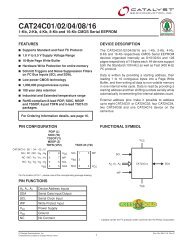CAPITOLUL 2 MODELAREA DATELOR - Baze de date
CAPITOLUL 2 MODELAREA DATELOR - Baze de date
CAPITOLUL 2 MODELAREA DATELOR - Baze de date
You also want an ePaper? Increase the reach of your titles
YUMPU automatically turns print PDFs into web optimized ePapers that Google loves.
Florin Rădulescu – <strong>Baze</strong> <strong>de</strong> <strong>date</strong> Capitolul 2 – Mo<strong>de</strong>larea <strong>date</strong>lor<br />
1. Entitati in<strong>de</strong>pen<strong>de</strong>nte (sau tari) sunt cele care au existenta in<strong>de</strong>pen<strong>de</strong>nta <strong>de</strong> alte<br />
entitati,<br />
2. Entitati <strong>de</strong>pen<strong>de</strong>nte (sau slabe) sunt formate din instante care isi justifica incadrarea<br />
in clasa respectiva doar atita timp cit intr-o alta entitate (tata) exista o anumita<br />
instanta <strong>de</strong> care sunt <strong>de</strong>pen<strong>de</strong>nte. De exemplu in cazul unei baze <strong>de</strong> <strong>date</strong> <strong>de</strong> personal,<br />
fiecare instanta a entitatii COPII ramine in clasa respectiva (copiii angajatilor) atit<br />
timp cit in entitatea ANGAJATI exista instanta reprezentand pe tatal/mama acelui<br />
copil.<br />
Element al<br />
mo<strong>de</strong>lului<br />
Entitate<br />
Atribut<br />
Asociere<br />
Tare<br />
Slaba<br />
Tip Reprezentare Exemplu<br />
De i<strong>de</strong>ntificare<br />
De Descriere<br />
Asociaza 1-2<br />
entitati<br />
Asociaza mai<br />
mult <strong>de</strong> 2<br />
entitati<br />
(exemplu: 3<br />
entitati)<br />
3: 6:<br />
Nume entitate STUDENT<br />
Nume entitate COPIL<br />
Nume<br />
atribut<br />
Nume<br />
atribut<br />
Nume asociere<br />
. . . . . . .<br />
6<br />
Alocare<br />
CodStu<strong>de</strong>nt<br />
Inscris_La<br />
Fig. 2.2. Conventia <strong>de</strong> reprezentare a elementelor mo<strong>de</strong>lului EA<br />
Nume<br />
Atributele mo<strong>de</strong>leaza proprietati atomice distincte ale entitatilor. De exemplu entitatea<br />
STUDENTI poate avea ca atribute Matricola, Nume, Prenume, Varsta, Anul, Grupa, etc.<br />
In procesul <strong>de</strong> mo<strong>de</strong>lare vor fi luate in consi<strong>de</strong>rare doar acele proprietati ale entitatilor<br />
care sunt semnificative pentru aplicatia respectiva. Din acest motiv, la entitatea<br />
STUDENTI nu vom lua in consi<strong>de</strong>rare caracteristici ca Talia sau Culoarea_parului<br />
acestea nefiind necesare pentru baza <strong>de</strong> <strong>date</strong> a universitatii (astfel <strong>de</strong> atribute ar putea<br />
exista <strong>de</strong> exemplu intr-o baza <strong>de</strong> <strong>date</strong> privind personalul militar).<br />
Atributele unei entitati sunt <strong>de</strong> doua feluri:<br />
• atributele <strong>de</strong> i<strong>de</strong>ntificare (formand impreuna i<strong>de</strong>ntificatorul entitatii) reprezinta<br />
acea multime <strong>de</strong> atribute care permit distinctia intre instantele aceleiasi entitati


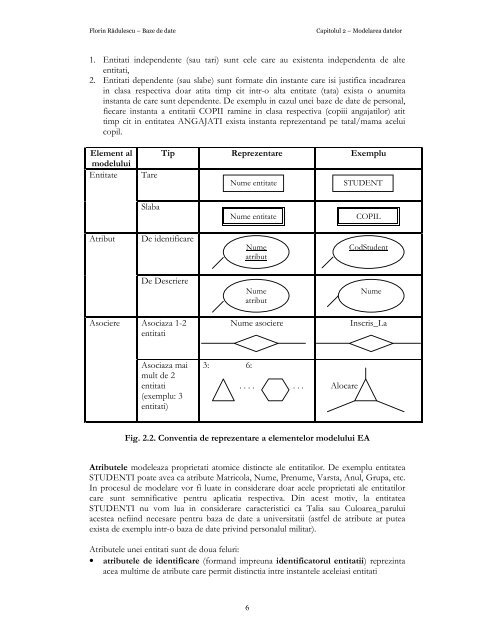
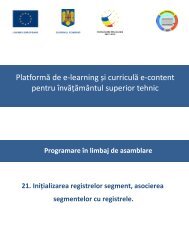
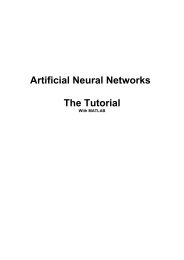
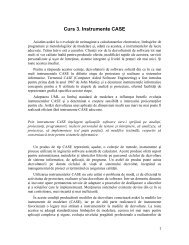
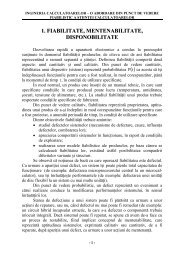
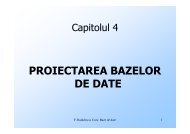
![Florian Moraru - Structuri de date [pdf] - Andrei](https://img.yumpu.com/16899682/1/184x260/florian-moraru-structuri-de-date-pdf-andrei.jpg?quality=85)
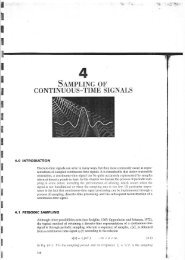
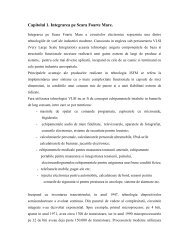
![Capitolul 2 - Elemente de mecanică cuantică [pdf] - Andrei](https://img.yumpu.com/16899601/1/190x245/capitolul-2-elemente-de-mecanica-cuantica-pdf-andrei.jpg?quality=85)

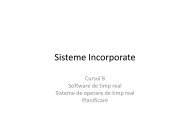
![Curs 2 - Gestiunea sistemului de fișiere [pdf] - Andrei](https://img.yumpu.com/16899511/1/190x143/curs-2-gestiunea-sistemului-de-fisiere-pdf-andrei.jpg?quality=85)
![Curs 5 - Performanțele circuitelor VLSI [pdf] - Andrei](https://img.yumpu.com/16899506/1/190x245/curs-5-performantele-circuitelor-vlsi-pdf-andrei.jpg?quality=85)
